Popular categories
Looking for a yarn?
Order DROPS Needles & Hooks
Clicking the ORDER button will redirect you to Wool Warehouse Direct Ltd website
The yarn cost is calculated from the pattern’s smallest size and the yarn’s cheapest product type. Looking for an even better price? You might find it on the DROPS Deals!
Tiny Cloud
Knitted jumper for children in DROPS Sky. The piece is worked top down with double neck and saddle shoulders. Sizes 3 – 14 years.
DROPS Design: Pattern no sk-014-bn
Yarn group B
-------------------------------------------------------
SIZES:
3/4 - 5/6 - 7/8 - 9/10 - 11/12 - 13/14 years
Equivalent to child’s height in cm:
98/104 - 110/116 - 122/128 - 134/140 - 146/152 - 158/164
MATERIALS:
DROPS SKY from Garnstudio (belongs to yarn group B)
150-150-150-200-200-200 g colour 15, aquamarine
KNITTING TENSION:
21 stitches in width and 28 rows in height with stocking stitch = 10 x 10 cm.
NEEDLES:
DROPS DOUBLE POINTED NEEDLES SIZE 4 MM.
DROPS CIRCULAR NEEDLE SIZE 4 MM: Length 40 cm and 60 cm or 80 cm for stocking stitch.
DROPS DOUBLE POINTED NEEDLES SIZE 3 MM.
DROPS CIRCULAR NEEDLE SIZE 3 MM: Length 40 cm and 60 cm or 80 cm for rib.
Needle size is only a guide. If you get too many stitches on 10 cm, change to a larger needle size. If you get too few stitches on 10 cm, change to a smaller needle size.
-------------------------------------------------------
Alternative Yarn – See how to change yarns here
Yarn Groups A to F – Use the same pattern and change the yarn here
Yarn usage using an alternative yarn – Use our yarn converter here
-------------------------------------------------------
Order DROPS Needles & Hooks
Clicking the ORDER button will redirect you to Wool Warehouse Direct Ltd website
The yarn cost is calculated from the pattern’s smallest size and the yarn’s cheapest product type. Looking for an even better price? You might find it on the DROPS Deals!
- English (UK/cm)
- Česky
- Dansk
- Deutsch
- Eesti keel
- English (US/in)
- Español
- Français
- Íslenska
- Italiano
- Magyar
- Nederlands
- Norsk
- Polski
- Português
- Suomi
- Svenska
- English (UK/cm), Bulgaria
- English (UK/cm), Croatia
- English (UK/cm), Greece
- English (UK/cm), Latvia
- English (UK/cm), Lithuania
- English (UK/cm), Romania
- English (UK/cm), Slovenia
- Česky, Slovakia
Pattern instructions
EXPLANATIONS FOR THE PATTERN:
-------------------------------------------------------
INCREASE TIP-1 (evenly spaced):
To work out how to increase evenly, count the total number of stitches on the needle (e.g. 78 stitches) and divide by the number of increases to be made (e.g. 18) = 4.3.
In this example, increase by making 1 yarn over after approx. each 4th stitch. On the next round work the yarn overs twisted to avoid holes.
INCREASE TIP-2 (for saddle shoulders, sleeves and yoke):
BEFORE MARKER:
The new stitch twists to the right.
Use the left needle to pick up the strand between 2 stitches from the previous round, pick up the back strand and knit in the front loop.
AFTER MARKER:
The new stitch twists to the left.
Use the left needle to pick up the strand between 2 stitches from the previous round, pick up the front strand and knit in the back loop.
DECREASE TIP (for sleeves):
Start 3 stitches before the marker thread, knit 2 together, knit 2 (marker thread sits between these 2 stitches), slip 1 stitch as if to knit, knit 1 and pass the slipped stitch over the knitted stitch (2 stitches decreased).
CASTING-OFF TIP:
To avoid the cast-off edge being tight you can cast off with a larger size needle. If the edge is still tight, make 1 yarn over after approx. each 6th stitch at the same time as casting off; the yarn overs are cast off as normal stitches.
-------------------------------------------------------
START THE PIECE HERE:
-------------------------------------------------------
JUMPER – SHORT OVERVIEW OF THE PIECE:
The neck and yoke are worked in the round with circular needle, from the right shoulder and top down. Stitches are increased for the saddle shoulders, then for the sleeves and finally for the yoke.
The yoke is divided for the body and sleeves and the body continued in the round. The sleeves are worked in the round with double pointed needles, top down.
DOUBLE NECK:
Cast on 78-80-82-84-86-88 stitches with short circular needle size 3 mm and Sky.
Work rib in the round (knit 1, purl 1) for 7 cm.
When the rib is finished, knit 1 round where you increase 18-20-22-20-22-24 stitches evenly spaced – read INCREASE TIP-1 = 96-100-104-104-108-112 stitches.
Knit 1 round (yarn overs knitted twisted). Now work the yoke as described below.
YOKE:
Change to circular needle size 4 mm. Count 31-32-34-35-36-37 stitches and insert 1 marker before the next stitch = mid-front. The yoke is measured from this marker!
In addition insert 4 other markers, without working the stitches, as follows – each marker is inserted between 2 stitches, is used when increasing for the saddle shoulders and should have a different colour to the marker on the neck.
Marker 1: Insert the marker before the first stitch on the round = back of right shoulder.
Marker 2: Count 14-14-16-18-18-18 stitches from marker 1 (= shoulder), insert the marker before the next stitch.
Marker 3: Count 34-36-36-34-36-38 stitches from marker 2 (= front piece), insert the marker before the next stitch.
Marker 4: Count 14-14-16-18-18-18 stitches from marker 3 (= shoulder), insert the marker before the next stitch.
There are 34-36-36-34-36-38 stitches left on the round after marker 4 (= back piece).
Allow these 4 markers to follow your work onwards.
SADDLE-SHOULDER INCREASES:
Read the whole section before continuing! Work stocking stitch in the round.
AT THE SAME TIME, on the first round, increase 4 stitches for the shoulders as follows:
Increase BEFORE markers 1 and 3 and AFTER markers 2 and 4 – read INCREASE TIP-2. You are only increasing on the front and back pieces, the number of shoulder stitches remains the same.
Increase like this every round a total of 12-14-16-20-22-26 times = 144-156-168-184-196-216 stitches – the increased stitches are worked in stocking stitch. REMEMBER THE KNITTING TENSION!
After the last increase the piece measures approx. 4-5-6-7-8-9 cm from the marker mid-front. Now increase for the sleeves as follows.
SLEEVE INCREASES:
Continue with stocking stitch.
AT THE SAME TIME on the next round increase 4 stitches for the sleeves as follows:
Increase AFTER markers 1 and 3 and BEFORE markers 2 and 4.
You increase only on the sleeves and the number of stitches on the front and back pieces remains the same. The new stitches are worked in stocking stitch.
Increase like this every 2nd round a total of 10-10-8-7-7-7 times = 184-196-200-212-224-244 stitches.
The piece measures approx. 11-12-12-12-13-14 cm from the marker mid-front. Now increase for the yoke as described below.
YOKE INCREASES:
Move the 4 markers so each marker sits in the outermost stitches on each side of the front piece and back piece. There are now 34-34-32-32-32-32 stitches between the marker-stitches on each sleeve.
On the next round increase 8 stitches, by increasing both before and after all 4 marker-stitches – remember INCREASE TIP-2.
You are now increasing on the front/back pieces and on the sleeves; the increased stitches are worked in stocking stitch.
Increase like this every 2nd round a total of 5-5-6-5-5-4 times = 224-236-248-252-264-276 stitches.
When all the increases are finished, the piece measures approx. 15-16-16-16-17-17 cm from the marker mid-front.
Continue working stocking stitch, without further increases, until the piece measures 15-16-16-17-18-19 cm from the marker mid-front – finish the last round when there are 1-2-3-4-5-7 stitches left on the round.
Now divide the yoke for the body and sleeves as follows: Place the first 46-48-50-50-52-54 stitches on 1 thread for the sleeve, cast on 6-6-6-8-8-8 new stitches (= in side under sleeve), work the next 66-70-74-76-80-84 stitches (= front piece), place the next 46-48-50-50-52-54 stitches on 1 thread for the sleeve, cast on 6-6-6-8-8-8 new stitches (= in side under sleeve), work the last 66-70-74-76-80-84 stitches (= back piece).
The body and sleeves are finished separately. THE PIECE IS NOW MEASURED FROM HERE.
BODY:
= 144-152-160-168-176-184 stitches.
Continue with stocking stitch in the round until the piece measures 15-18-21-24-25-26 cm from the division. There is approx. 3 cm left to finished length; try the jumper on and work to desired length.
Change to circular needle size 3 mm and work rib (knit 1, purl 1) for 3 cm. Cast off with knit over knit and purl over purl – read CASTING-OFF TIP! The jumper measures approx. 36-40-44-48-50-52 cm from the shoulder down.
SLEEVES:
Place the 46-48-50-50-52-54 stitches from the thread on the one side of the piece on double pointed needles size 4 mm and knit up 1 stitch in each of the 6-6-6-8-8-8 stitches cast on under the sleeve = 52-54-56-58-60-62 stitches. Insert a marker thread in the middle of the 6-6-6-8-8-8 new stitches under the sleeve.
Start at the marker thread and work stocking stitch in the round.
When the sleeve measures 2-2-3-3-3-3 cm from the division, decrease 2 stitches mid-under the sleeve – read DECREASE TIP. Decrease like this every 2½-2½-3-3-4-4 cm a total of 7-8-8-9-9-10 times = 38-38-40-40-42-42 stitches.
Continue working without further decreases until the sleeve measures 21-25-30-34-38-43 cm from the division.
There is approx. 3 cm left to finished length; try the jumper on and work to desired length.
Change to double pointed needles size 3 mm and work rib (knit 1, purl 1) for 3 cm. Cast off with knit over knit and purl over purl – remember CASTING-OFF TIP! The sleeve measures approx. 24-28-33-37-41-45 cm from the division. Work the other sleeve in the same way.
ASSEMBLY:
Fold the neck double to the wrong side and sew down. To avoid the neck being tight and rolling outwards, it is important the seam is elastic.
Diagram

|
= knitting direction |

|
= increase for saddle-shoulders |

|
= increase for sleeves |

|
= increase for yoke |

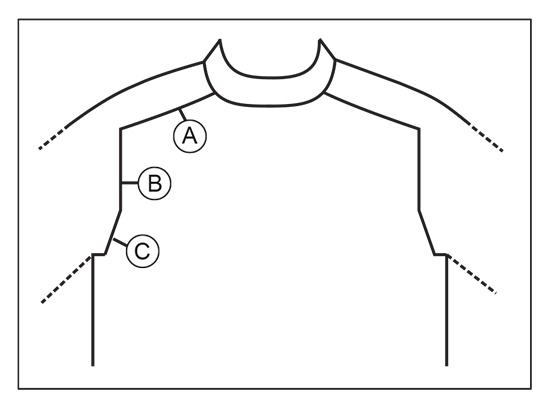
What can you do with our patterns? You can share DROPS patterns online, using the pattern original picture, materials, name and number. But you are NOT ALLOWED to reproduce the complete pattern digitally in any way. Yarn stores are welcome to use the DROPS pattern database to promote the sale of our assortment. You can print out our patterns, make as many copies as you’d like. The only thing we ask is that you don't make any changes / additions to the original printed document. And that the patterns according to the DROPS philosophy are given out to the consumers for free. Editorials that wish to publish our patterns in printed books or magazines can contact us for more information. The sale of garments based on DROPS patterns is permitted as long as they are sold as single items or per order. Further commercial use of the patterns is not permitted. It has to be clearly stated that the garment is made based on a design from DROPS DESIGN. The use of clothing labels of which DROPS DESIGN forms part is conditioned by the inclusion of the following text: “A DROPS DESIGN made by …..”. The use of DROPS photos for marketing purposes/sales is only permitted in connection with the use/sale of DROPS products. The photos may not be cut or edited and the logo should be clearly visible.
We reserve the right to withdraw the permission for use of our patterns at any time, notwithstanding the reason.
Each of our patterns has specific tutorial videos to help you.
These step-by-step tutorials might also help you:
Why is the knitting/crochet tension so important?
Knitting tension is what determines the final measurements of your work, and is usually measured per 10 x 10 cm. It is provided like so: number of stitches in width x number of rows in height - eg: 19 stitches x 26 rows = 10 x 10 cm.
The knitting tension is very individual; some people knit/crochet loosely while others work tightly. You adjust the knitting tension with the needle size, which is why the suggested needle size is only meant as a guide! You need to adjust this (up or down) to ensure that YOUR knitting tension matches the knitting tension provided in the pattern. If you work with a different knitting tension than provided you will have a different yarn consumption, and your work will have different measurements than what the pattern suggests.
The knitting tension also determines which yarns can replace each other. As long as you achieve the same knitting tension you can replace one yarn with another.
See DROPS lesson: How to measure your tension/gauge
See DROPS video: How to make a gauge tension swatch
How do I know how many balls of yarn I need?
The required amount of yarn is provided in grams, eg: 450 g. To calculate how many balls you’ll need you first need to know how many grams are in 1 ball (25g, 50g or 100g). This information is available if you click on the individual yarn quality on our pages. Divide the amount required with the amount of each ball. For example, if each ball is 50g (the most common amount), the calculation will be as follows: 450 / 50 = 9 balls.
Can I use a different yarn than what the pattern suggests?
The important thing when changing from one yarn to another is that the knitting/crochet tension remains the same. This is so that the measurements of the finished piece will be the same as on the sketch provided. It is easier to achieve the same knitting tension using yarns from the same yarn group. It is also possible to work with multiple strands of a thinner yarn to achieve the knitting tension of a thicker one. Please try our yarn converter. We recommend you to always work a test swatch.
Please NOTE: when changing yarn the garment might have a different look and feel to the garment in the photo, due to individual properties and qualities of each yarn.
See DROPS lesson: Can I use a different yarn than the one mentioned in the pattern?
What are the yarn groups?
All our yarns are categorised into yarn groups (from A to F) according to thickness and knitting tension – group A contains the thinnest yarns and group F the thickest. This makes it easier for you to find alternative yarns to our patterns, should you wish to switch yarn. All yarns within the same group have a similar knitting tension and can easily replace each other. However, different yarn qualities have different structures and properties which will give the finished work a unique look and feel.
How do I use the yarn calculator?
At the top of all our patterns you’ll find a link to our yarn calculator, which is a helpful tool should you wish to use a different yarn than suggested. By filling in the yarn quality you wish to replace, the amount (in your size) and number of strands, the calculator will present good alternative yarns with the same knitting tension. Additionally it will tell you how much you’ll require in the new qualities and whether you’ll need to work with multiple strands. Most skeins are 50g (some are 25g or 100g).
If the pattern is worked with multiple colours, every colour will have to be calculated separately. Similarly, if the pattern is worked with several strands of different yarns (for example 1 strand Alpaca and 1 strand Kid-Silk) you will have to find alternatives for each, individually.
Why do you show discontinued yarns in the patterns?
Since different yarns have different qualities and textures we have chosen to keep the original yarn in our patterns. However, you can easily find options among our available qualities by using our yarn calculator, or simply pick a yarn from the same yarn group.
It is possible that some retailers still have discontinued yarns in stock, or that someone has a few skeins at home that they would like to find patterns for.
The yarn calculator will provide both alternative yarn as well as required amount in the new quality.
What size should I knit?
If you think it's hard to decide what size to make, it can be a good idea to measure a garment you own already and like the size of. Then you can pick the size by comparing those measures with the ones available in the pattern's size chart.
You'll find the size chart at the bottom of the pattern.
See DROPS lesson: How to read size chart
Why do I get the wrong knitting tension with the suggested needle size?
The needle size provided in the pattern serves only as a guide, the important thing is to follow the knitting tension. And since knitting tension is very individual, you will have to adjust the needle size to ensure that YOUR tension is the same as in the pattern – maybe you’ll have to adjust 1, or even 2 needle sizes, up or down to achieve the correct tension. For this, we recommend that you work test swatches.
Should you work with a different knitting tension than the one provided, the measurements of the finished garment might deviate from the measurement sketch.
See DROPS lesson: How to measure your tension/gauge
See DROPS video: How to make a tension/gauge swatch
Why is the pattern worked top-down?
Working a garment top-down provides more flexibility and room for personal adjustment. For example it is easier to try the garment on while working, as well as making adjustments to length of yoke and shoulder caps.
The instructions are carefully explaining every step, in the correct order. Diagrams are adjusted to the knitting direction and are worked as usual.
How do I work according to a knitting diagram?
The diagram depicts all rows/rounds, and every stitch seen from the right side. It is read from bottom to top, from right to left. 1 square = 1 stitch.
When working back and forth, every other row is worked from the right side and every other row is worked from the wrong side. When working from the wrong side, the diagram will have to be worked reversed: from left to right, knit stitches are purled, purl stitches are knit etc.
When working in the round every round is worked from the right side and the diagram are worked from right to left on all rounds.
See DROPS lesson: How to read knitting diagrams
How do I work according to a crochet diagram?
The diagram depicts all rows/rounds, and every stitch seen from the right side. It is worked from bottom to top, from right to left.
When working back and forth every other row is worked from the right side: from right to left and every other row is worked from the wrong side: from left to right.
When working in the round, every row in the diagram are worked from the right side, from right to left.
When working a circular diagram you start in the middle and work your way outwards, counter clockwise, row by row.
The rows usually start with a given number of chain stitches (equivalent to the height of the following stitch), this will either be depicted in the diagram or explained in the pattern.
See DROPS lesson: How to read crochet diagrams
How do I work several diagrams simultaneously on the same row/round?
Instructions for working several diagrams after each other on the same row/round, will often be written like so: “work A.1, A.2, A.3 a total of 0-0-2-3-4 times". This means you work A.1 once, then A.2 is worked once, and A.3 is repeated (in width) the number of times provided for your size – in this case like so: S = 0 times, M = 0 times, L=2 times, XL= 3 times and XXL = 4 times.
The diagrams are worked as usual: begin with the first row in A.1, then work the first row in A.2 etc.
See DROPS lesson: How to read knitting diagrams
See DROPS lesson: How to read crochet diagrams
Why are the sleeves shorter in larger sizes?
The total width of the garment (from wrist-to-wrist) will be larger in the larger sizes, despite the actual sleeves being shorter. The larger sizes have longer sleeve caps and wider shoulders, so there will be a good fit in all sizes.
Where on the garment is the length measured?
The measurement sketch/schematic drawing provides information regarding the full length of the garment. If it’s a jumper or a jacket the length is measured from the highest point on the shoulder closest to the neckline, and straight down to the bottom of the garment. It is NOT measured from the tip of shoulder. Similarly, the length of yoke is measured from the highest point on the shoulder and down to where yoke is split into body and sleeves.
On a jacket measures are never taken along bands, unless specifically stated. Always measure inside band stitches when measuring the length.
See DROPS lesson: How to read a schematic drawing
What is a repeat?
Diagrams are often repeated on the round or in height. 1 repeat is the diagram the way it appears in the pattern. If it says to work 5 repeats of A.1 in the round, then you work A.1 a total of 5 times after/next to each other in the round. If it says to work 2 repeats of A.1 vertically/in height you work the entire diagram once, then begin again at the start and work the entire diagram one more time.
Why does the piece start with more chain stitches than it’s worked with?
Chain stitches are slightly narrower than other stitches and to avoid working the cast-on edge too tight, we simply chain more stitches to begin with. The stitch count will be adjusted on the following row to fit the pattern and measurement sketch.
Why increase before the rib edge when the piece is worked top-down?
The rib edge is more elastic and will contract slightly compared to, for example, stocking stitch. By increasing before the rib edge, you avoid a visible difference in width between the rib edge and the rest of the body.
Why increase in the cast-off edge?
It’s very easy to cast off too tightly, and by making yarn overs while casting off (and simultaneously casting these off) you avoid a too tight cast off edge.
See DROPS video: How to bind off with yarn overs (yo)
How do I increase/decrease on every 3rd and 4th row/round alternately?
To achieve an even increase (or decrease) you can increase on, for example: every 3rd and 4th row alternately, like so: work 2 rows and increase on the 3rd row, work 3 rows and increase on the 4th. Repeat this until the increase is complete.
See DROPS lesson: Increase or decrease 1 st on every 3rd and 4th row alternately
How can I work a jacket in the round instead of back and forth?
Should you prefer to work in the round instead of back and forth, you may of course adjust the pattern. You’ll need to add steeks mid-front (usually 5 stitches), and follow the instructions. When you would normally turn and work from the wrong side, simply work across the steek and continue in the round. At the end you’ll cut the piece open, pick up stitches to work bands, and cover the cut edges.
See DROPS video: How to knit steeks and cut open
Can I work a jumper back and forth instead of in the round?
Should you prefer to work back and forth instead of in the round, you may of course adjust the pattern so you work the pieces separately and then assemble them at the end. Divide the stitches for the body in 2, add 1 edge stitch in each side (for sewing) and work the front and back pieces separately.
See DROPS lesson: Can I adapt a pattern for circular needles into straight needles?
Why is the pattern slightly different than what I see in the photo?
Pattern repeats can vary slightly in the different sizes, in order to get the correct proportions. If you’re not working the exact same size as the garment in the photo, yours might deviate slightly. This has been carefully developed and adjusted so that the complete impression of the garment is the same in all sizes.
Make sure to follow instructions and diagrams for your size!
How do I make a women’s size garment into a men’s size one?
If you have found a pattern you like which is available in women’s size it’s not very difficult to convert it to men’s size. The biggest difference will be the length of sleeves and body. Start working on the women size that you think would fit across the chest. The additional length will be worked right before you cast off for the armhole/sleeve cap. If the pattern is worked top-down you can add the length right after the armhole or before the first decrease on sleeve.
Regarding additional yarn amount, this will depend on how much length you add, but it is better with a skein too many than too few.
How do I prevent a hairy garment from shedding?
All yarns will have excess fibres (from production) that might come off as lint or shedding. Brushed yarns (ie hairier yarns) have more of these loose, excess fibres, causing more shedding.
Shedding also depends on what is worn under or over the garment, and whether this pulls at the yarn fibres. It’s therefore not possible to guarantee that there will be no shedding
Below are some tips on how to get the best result when working with hairier yarns:
1. When the garment is finished (before you wash it) shake it vigorously so the looser hairs come off. NOTE: do NOT use a lint roller, brush or any method that pulls at the yarn.
2. Place the garment in a plastic bag and put it in your freezer - the temperature will cause the fibres to become less attached to each other, and excess fibres will come off easier.
3. Leave in the freezer for a few hours before taking it out and shaking it again.
4. Wash the garment according to the instructions on the yarn label.
Why does my garment pill?
Pilling is a natural process that happens to even the most exclusive of fibers. It's a natural sign of wear and tear that is hard to avoid, and that is most visible in high friction areas of your garment like a sweater's arms and cuffs.
You can make your garment look as new by removing the pilling, using a fabric comb or a pill/lint remover.
In the meantime, you can read the questions and answers that others have left to this pattern or join the DROPS Workshop on Facebook to get help from fellow knitters/crocheters!
You might also like...
Tiny Cloud |
|||||||||||||
 |
 |
||||||||||||
Knitted jumper for children in DROPS Sky. The piece is worked top down with double neck and saddle shoulders. Sizes 3 – 14 years.
DROPS Children 40-14 |
|||||||||||||
|
------------------------------------------------------- EXPLANATIONS FOR THE PATTERN: ------------------------------------------------------- INCREASE TIP-1 (evenly spaced): To work out how to increase evenly, count the total number of stitches on the needle (e.g. 78 stitches) and divide by the number of increases to be made (e.g. 18) = 4.3. In this example, increase by making 1 yarn over after approx. each 4th stitch. On the next round work the yarn overs twisted to avoid holes. INCREASE TIP-2 (for saddle shoulders, sleeves and yoke): BEFORE MARKER: The new stitch twists to the right. Use the left needle to pick up the strand between 2 stitches from the previous round, pick up the back strand and knit in the front loop. AFTER MARKER: The new stitch twists to the left. Use the left needle to pick up the strand between 2 stitches from the previous round, pick up the front strand and knit in the back loop. DECREASE TIP (for sleeves): Start 3 stitches before the marker thread, knit 2 together, knit 2 (marker thread sits between these 2 stitches), slip 1 stitch as if to knit, knit 1 and pass the slipped stitch over the knitted stitch (2 stitches decreased). CASTING-OFF TIP: To avoid the cast-off edge being tight you can cast off with a larger size needle. If the edge is still tight, make 1 yarn over after approx. each 6th stitch at the same time as casting off; the yarn overs are cast off as normal stitches. ------------------------------------------------------- START THE PIECE HERE: ------------------------------------------------------- JUMPER – SHORT OVERVIEW OF THE PIECE: The neck and yoke are worked in the round with circular needle, from the right shoulder and top down. Stitches are increased for the saddle shoulders, then for the sleeves and finally for the yoke. The yoke is divided for the body and sleeves and the body continued in the round. The sleeves are worked in the round with double pointed needles, top down. DOUBLE NECK: Cast on 78-80-82-84-86-88 stitches with short circular needle size 3 mm and Sky. Work rib in the round (knit 1, purl 1) for 7 cm. When the rib is finished, knit 1 round where you increase 18-20-22-20-22-24 stitches evenly spaced – read INCREASE TIP-1 = 96-100-104-104-108-112 stitches. Knit 1 round (yarn overs knitted twisted). Now work the yoke as described below. YOKE: Change to circular needle size 4 mm. Count 31-32-34-35-36-37 stitches and insert 1 marker before the next stitch = mid-front. The yoke is measured from this marker! In addition insert 4 other markers, without working the stitches, as follows – each marker is inserted between 2 stitches, is used when increasing for the saddle shoulders and should have a different colour to the marker on the neck. Marker 1: Insert the marker before the first stitch on the round = back of right shoulder. Marker 2: Count 14-14-16-18-18-18 stitches from marker 1 (= shoulder), insert the marker before the next stitch. Marker 3: Count 34-36-36-34-36-38 stitches from marker 2 (= front piece), insert the marker before the next stitch. Marker 4: Count 14-14-16-18-18-18 stitches from marker 3 (= shoulder), insert the marker before the next stitch. There are 34-36-36-34-36-38 stitches left on the round after marker 4 (= back piece). Allow these 4 markers to follow your work onwards. SADDLE-SHOULDER INCREASES: Read the whole section before continuing! Work stocking stitch in the round. AT THE SAME TIME, on the first round, increase 4 stitches for the shoulders as follows: Increase BEFORE markers 1 and 3 and AFTER markers 2 and 4 – read INCREASE TIP-2. You are only increasing on the front and back pieces, the number of shoulder stitches remains the same. Increase like this every round a total of 12-14-16-20-22-26 times = 144-156-168-184-196-216 stitches – the increased stitches are worked in stocking stitch. REMEMBER THE KNITTING TENSION! After the last increase the piece measures approx. 4-5-6-7-8-9 cm from the marker mid-front. Now increase for the sleeves as follows. SLEEVE INCREASES: Continue with stocking stitch. AT THE SAME TIME on the next round increase 4 stitches for the sleeves as follows: Increase AFTER markers 1 and 3 and BEFORE markers 2 and 4. You increase only on the sleeves and the number of stitches on the front and back pieces remains the same. The new stitches are worked in stocking stitch. Increase like this every 2nd round a total of 10-10-8-7-7-7 times = 184-196-200-212-224-244 stitches. The piece measures approx. 11-12-12-12-13-14 cm from the marker mid-front. Now increase for the yoke as described below. YOKE INCREASES: Move the 4 markers so each marker sits in the outermost stitches on each side of the front piece and back piece. There are now 34-34-32-32-32-32 stitches between the marker-stitches on each sleeve. On the next round increase 8 stitches, by increasing both before and after all 4 marker-stitches – remember INCREASE TIP-2. You are now increasing on the front/back pieces and on the sleeves; the increased stitches are worked in stocking stitch. Increase like this every 2nd round a total of 5-5-6-5-5-4 times = 224-236-248-252-264-276 stitches. When all the increases are finished, the piece measures approx. 15-16-16-16-17-17 cm from the marker mid-front. Continue working stocking stitch, without further increases, until the piece measures 15-16-16-17-18-19 cm from the marker mid-front – finish the last round when there are 1-2-3-4-5-7 stitches left on the round. Now divide the yoke for the body and sleeves as follows: Place the first 46-48-50-50-52-54 stitches on 1 thread for the sleeve, cast on 6-6-6-8-8-8 new stitches (= in side under sleeve), work the next 66-70-74-76-80-84 stitches (= front piece), place the next 46-48-50-50-52-54 stitches on 1 thread for the sleeve, cast on 6-6-6-8-8-8 new stitches (= in side under sleeve), work the last 66-70-74-76-80-84 stitches (= back piece). The body and sleeves are finished separately. THE PIECE IS NOW MEASURED FROM HERE. BODY: = 144-152-160-168-176-184 stitches. Continue with stocking stitch in the round until the piece measures 15-18-21-24-25-26 cm from the division. There is approx. 3 cm left to finished length; try the jumper on and work to desired length. Change to circular needle size 3 mm and work rib (knit 1, purl 1) for 3 cm. Cast off with knit over knit and purl over purl – read CASTING-OFF TIP! The jumper measures approx. 36-40-44-48-50-52 cm from the shoulder down. SLEEVES: Place the 46-48-50-50-52-54 stitches from the thread on the one side of the piece on double pointed needles size 4 mm and knit up 1 stitch in each of the 6-6-6-8-8-8 stitches cast on under the sleeve = 52-54-56-58-60-62 stitches. Insert a marker thread in the middle of the 6-6-6-8-8-8 new stitches under the sleeve. Start at the marker thread and work stocking stitch in the round. When the sleeve measures 2-2-3-3-3-3 cm from the division, decrease 2 stitches mid-under the sleeve – read DECREASE TIP. Decrease like this every 2½-2½-3-3-4-4 cm a total of 7-8-8-9-9-10 times = 38-38-40-40-42-42 stitches. Continue working without further decreases until the sleeve measures 21-25-30-34-38-43 cm from the division. There is approx. 3 cm left to finished length; try the jumper on and work to desired length. Change to double pointed needles size 3 mm and work rib (knit 1, purl 1) for 3 cm. Cast off with knit over knit and purl over purl – remember CASTING-OFF TIP! The sleeve measures approx. 24-28-33-37-41-45 cm from the division. Work the other sleeve in the same way. ASSEMBLY: Fold the neck double to the wrong side and sew down. To avoid the neck being tight and rolling outwards, it is important the seam is elastic. |
|||||||||||||
Diagram explanations |
|||||||||||||
|
|||||||||||||

|
|||||||||||||

|
|||||||||||||
|
Have you made this or any other of our designs? Tag your pictures in social media with #dropsdesign so we can see them! Do you need help with this pattern?You'll find tutorial videos, a Comments/Questions area and more by visiting the pattern on garnstudio.com. © 1982-2024 DROPS Design A/S. We reserve all rights. This document, including all its sub-sections, has copyrights. Read more about what you can do with our patterns at the bottom of each pattern on our site. |
|||||||||||||
With over 40 years in knitting and crochet design, DROPS Design offers one of the most extensive collections of free patterns on the internet - translated to 17 languages. As of today we count 304 catalogues and 11422 patterns - 11422 of which are translated into English (UK/cm).
We work hard to bring you the best knitting and crochet have to offer, inspiration and advice as well as great quality yarns at incredible prices! Would you like to use our patterns for other than personal use? You can read what you are allowed to do in the Copyright text at the bottom of all our patterns. Happy crafting!







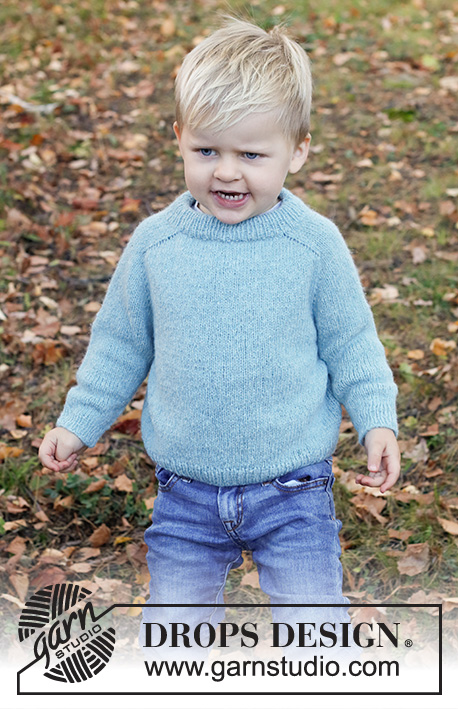
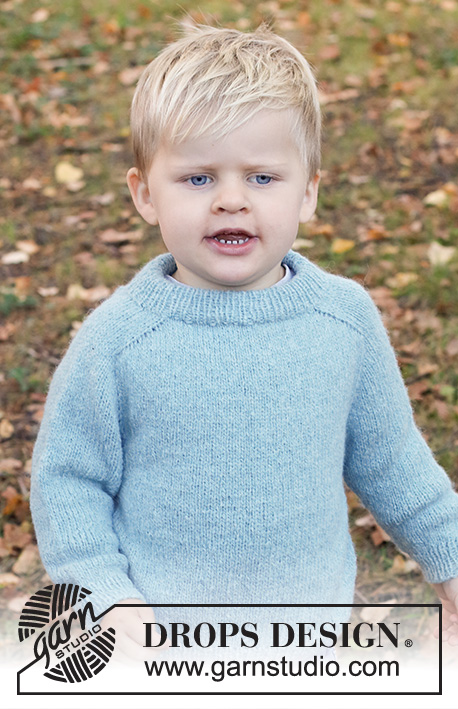
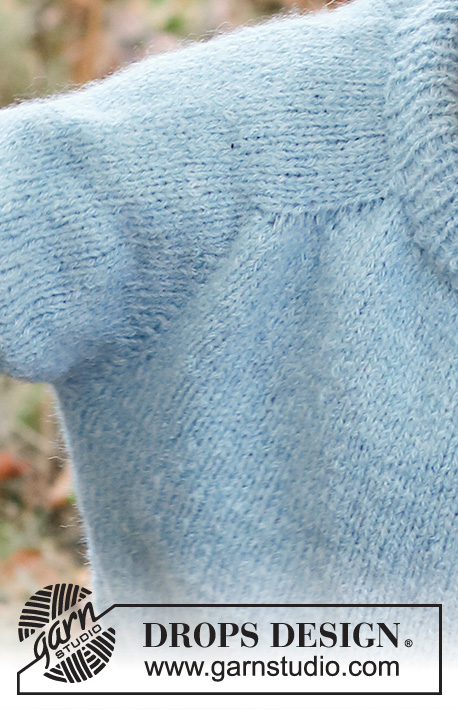


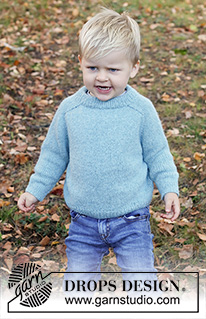
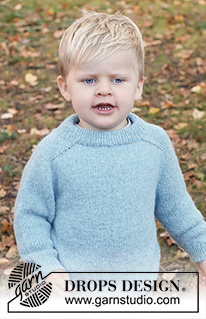








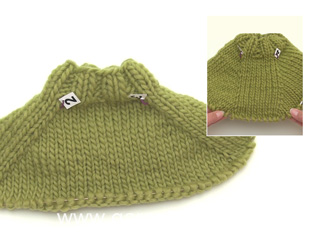
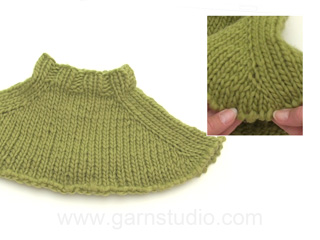
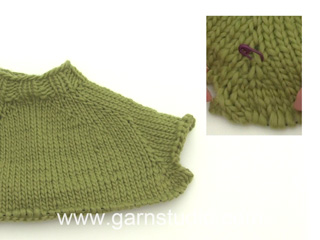








































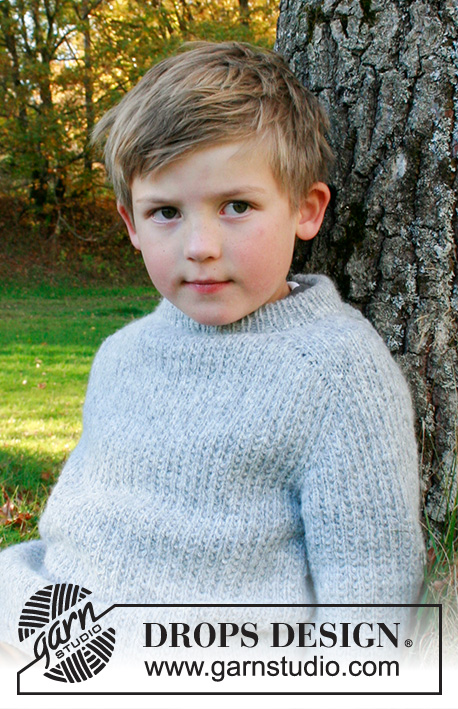






Comments / Questions (7)
Hello, you have a mistake in the grams required for size 5-6 and up, I'm using Karisma that is also in Group B, I am on my third ball and not even done with the body and missing the sleeves, I'm estimating it would take me close to the 300gr I purchased to make two sweaters. Just letting you know for other people trying this pattern
20.02.2024 - 14:06DROPS Design answered:
Dear Erika, this pattern is worked with DROPS Sky, which has a different metrage, this means you need 150 g DROPS Sky but if you like to use DROPS Karisma, that's right, you would need 300 g instead, see our converter. Happy knitting!
20.02.2024 - 15:58Ich stricke die kleinste Größe. In der Anleitung steht, dass nach der letzten Zuname für die sattelschulter 144 Maschen und 4cm Länge sind. Ich habe aber nur 116 Maschen bei 6cm schon. Hätte ich in jeder Runde zunehmen müssen? Ich habe jede Zunahmerunde abgestrickt. Die Mascherobe war perfekt, daran kann es nicht liegen
01.01.2024 - 21:13DROPS Design answered:
Liebe Nathalie, man soll in jeder Runde zunehmen, dh 12 Runden = ca 4 cm; 12 Runden mit je 4 Zunahmen sind 48 Zunahmen insgesamt + die 96 Maschen = 144 Maschen. Viel Spaß beim stricken!
02.01.2024 - 12:17Een vraag, ik ben bezig met patroon 40-14 maat 158/164. 3 bolletjes wol voor het lijf. Kan ik nog uit 1 bol twee mouwen breien? Zo nee, klopt het patroon niet qua hoeveelheid en heb ik 5 bollen nodig voor deze maat. Gr.
08.02.2023 - 14:34Bonjour, N'y a-t-il pas une erreur "quand toutes les augmentations sont faites l'ouvrage mesure 15,....cm puis continuer en jersey jusqu'à ce que l'ouvrage mesure 15.....cm "???? merci
18.01.2023 - 07:01DROPS Design answered:
Bonjour Anne, si vous avez la bonne tension en hauteur, alors vous aurez 15 cm après toutes les augmentations, sinon, vous devrez continuer jusqu'à ce que l'ouvrage mesure 15 cm; dans certaines tailles (les 3 plus grandes) on tricote encore 1 -2 cm après les dernières augmentations, mais pas dans les 3 premières tailles. Bon tricot!
18.01.2023 - 09:47Riittääkö 200g oikeasti isoimpaan kokoon?!
09.05.2022 - 14:58DROPS Design answered:
DROPS Sky on riittoisa lanka, joten 200 gramman tulisi riittää, kunhan neuletiheytesi on sama kuin ohjeessa annettu tiheys. Voit halutessasi varmuuden vuoksi hankkia yhden ylimääräisen kerän.
19.05.2022 - 17:22Bonjour je ne comprends pas où placer les marqueurs pour commencer les manches marteau. Pourquoi un marqueur milieu devant alors qu’il y a un marqueur début d’ouvrage milieu dos ?
02.05.2022 - 16:53DROPS Design answered:
Bonjour Mme Brodier, le marqueur du milieu dos sert de repère aux début des tours, celui du milieu devant sert de repère pour mesurer. Lorsque vous avez placé vos 4 marqueurs, vous allez augmenter avant les marqueurs 1 et 3 et après les marqueurs 2 et 4 (= pour le devant et le dos, le nombre de mailles entre les marqueurs 1 et 2 et les marqueurs 3 et 4 reste le même). cette vidéo montre comment procéder. Bon tricot!
03.05.2022 - 08:59Hej! Jag har ett ullgarn hemma med masktäthet 18 bredd och 25 höjd, 4,5-5,5 tjocka stickor. Kan detta garn funka till detta mönster? Hur ska jag tänka? Tack!
21.10.2021 - 16:43DROPS Design answered:
Hej Magdalena. Du kan testa med lite tunnare stickor för att se om du kan få en stickfasthet på 21 maskor på bredden och 28 varv på höjden med slätstickning = 10 x 10 cm med det garnet. Isåfall kan du använda det till detta mönster. Annars låter det som det garnet skulle passa bättre till ett mönster som passar för garngrupp C. Mvh DROPS Design
22.10.2021 - 08:36